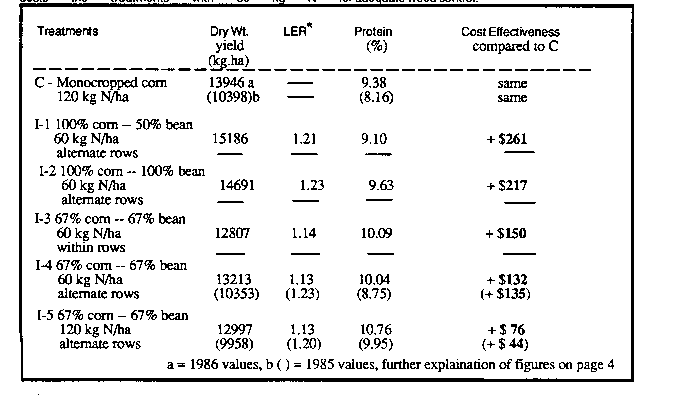
Sustainable Farming Index | Virtual Library | Magazine Rack
Search
| Ecological Solutions Roundtable
by Ralph Martin, Dr. Don Smith and Dr. Harvey Voldeng
Intercropping is being advocated as a new and improved approach to farming. However, it has been avoided because of the complications of planting and harvesting. Research was undertaken at Agriculture Canada in Ottawa during 1985 and 1986 to determine whether a corn-soybean intercrop could have yield, quality and economic advantages as compared to monocrops of corn and soybeans.
Intercropping involves competition for light, water and nutrients. It also restricts the herbicide options and complicates planting and harvesting. However, the intercrop usually benefits from increased light interception, root contact with more soil, increased microbial activity and can act as a deferent to pests and weeds of the other crop. There is also evidence that suggests intercropping may benefit a non-legume which needs nitrogen if the other crop is a legume, since legumes will fix nitrogen in the soil.
In the experiment Coop S259 corn as a monocrop was planted at 60 000 seeds/ha and Maple Arrow soybeans as a monocrop were planted at the rate of 500 000 seeds/ha (3.5 bu/ha).
The results from our research indicated that intercrops were more cost effective than monocropped corn in both years. With lower fertilizer costs the treatments with 60 kg N, fertilizer had an economic advantage of 130-260$/ha! As well, the quality or % crude protein of the intercrop silage was significantly higher than silage from monocropped com
For those farmers who would like to experiment with an intercrop of corn and soybeans, it would be simplest to start with corn at 67% (40 000 seeds/ha) and beans at 67% (2.33 bu/ha). The seeds of corn and soybeans (including inoculant) should be mixed well and planted with a corn planter in the same rows, 80 cm apart. The planter can then be set for 375 000 seeds/ha (40 000 corn, 335 000 beans) or about 3 bu/ha. The crop should be cultivated and a herbicide could be applied for adequate weed control.

Copyright © 1987 REAP Canada
Reprinted with permission. All rights reserved.
Info Request | Services | Become EAP Member | Site Map
Give us your comments about the EAP site
Ecological Agriculture Projects, McGill University (Macdonald
Campus),
Ste-Anne-de-Bellevue, QC, H9X 3V9 Canada
Telephone:
(514)-398-7771
Fax:
(514)-398-7621
Email: info@eap.mcgill.ca
To report problems or otherwise comment on the structure of this site, send mail to the Webmaster